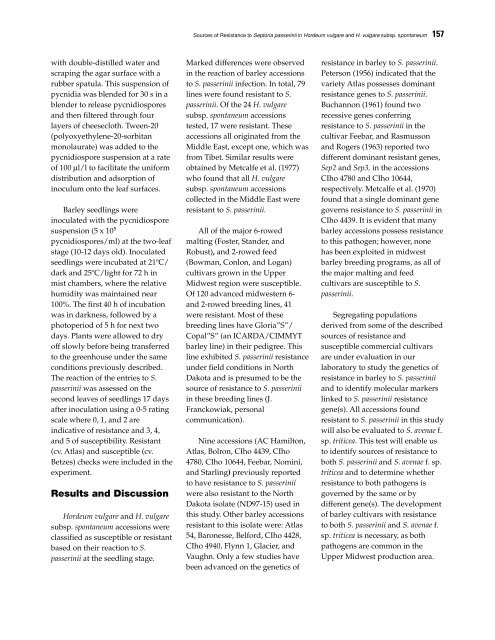Septoria and Stagonospora Diseases of Cereals - CIMMYT ...
Septoria and Stagonospora Diseases of Cereals - CIMMYT ...
Septoria and Stagonospora Diseases of Cereals - CIMMYT ...
You also want an ePaper? Increase the reach of your titles
YUMPU automatically turns print PDFs into web optimized ePapers that Google loves.
with double-distilled water <strong>and</strong><br />
scraping the agar surface with a<br />
rubber spatula. This suspension <strong>of</strong><br />
pycnidia was blended for 30 s in a<br />
blender to release pycnidiospores<br />
<strong>and</strong> then filtered through four<br />
layers <strong>of</strong> cheesecloth. Tween-20<br />
(polyoxyethylene-20-sorbitan<br />
monolaurate) was added to the<br />
pycnidiospore suspension at a rate<br />
<strong>of</strong> 100 µl/l to facilitate the uniform<br />
distribution <strong>and</strong> adsorption <strong>of</strong><br />
inoculum onto the leaf surfaces.<br />
Barley seedlings were<br />
inoculated with the pycnidiospore<br />
suspension (5 x 10 5<br />
pycnidiospores/ml) at the two-leaf<br />
stage (10-12 days old). Inoculated<br />
seedlings were incubated at 21ºC/<br />
dark <strong>and</strong> 25ºC/light for 72 h in<br />
mist chambers, where the relative<br />
humidity was maintained near<br />
100%. The first 40 h <strong>of</strong> incubation<br />
was in darkness, followed by a<br />
photoperiod <strong>of</strong> 5 h for next two<br />
days. Plants were allowed to dry<br />
<strong>of</strong>f slowly before being transferred<br />
to the greenhouse under the same<br />
conditions previously described.<br />
The reaction <strong>of</strong> the entries to S.<br />
passerinii was assessed on the<br />
second leaves <strong>of</strong> seedlings 17 days<br />
after inoculation using a 0-5 rating<br />
scale where 0, 1, <strong>and</strong> 2 are<br />
indicative <strong>of</strong> resistance <strong>and</strong> 3, 4,<br />
<strong>and</strong> 5 <strong>of</strong> susceptibility. Resistant<br />
(cv. Atlas) <strong>and</strong> susceptible (cv.<br />
Betzes) checks were included in the<br />
experiment.<br />
Results <strong>and</strong> Discussion<br />
Hordeum vulgare <strong>and</strong> H. vulgare<br />
subsp. spontaneum accessions were<br />
classified as susceptible or resistant<br />
based on their reaction to S.<br />
passerinii at the seedling stage.<br />
Sources <strong>of</strong> Resistance to <strong>Septoria</strong> passerinii in Hordeum vulgare <strong>and</strong> H. vulgare subsp. spontaneum 157<br />
Marked differences were observed<br />
in the reaction <strong>of</strong> barley accessions<br />
to S. passerinii infection. In total, 79<br />
lines were found resistant to S.<br />
passerinii. Of the 24 H. vulgare<br />
subsp. spontaneum accessions<br />
tested, 17 were resistant. These<br />
accessions all originated from the<br />
Middle East, except one, which was<br />
from Tibet. Similar results were<br />
obtained by Metcalfe et al. (1977)<br />
who found that all H. vulgare<br />
subsp. spontaneum accessions<br />
collected in the Middle East were<br />
resistant to S. passerinii.<br />
All <strong>of</strong> the major 6-rowed<br />
malting (Foster, St<strong>and</strong>er, <strong>and</strong><br />
Robust), <strong>and</strong> 2-rowed feed<br />
(Bowman, Conlon, <strong>and</strong> Logan)<br />
cultivars grown in the Upper<br />
Midwest region were susceptible.<br />
Of 120 advanced midwestern 6<strong>and</strong><br />
2-rowed breeding lines, 41<br />
were resistant. Most <strong>of</strong> these<br />
breeding lines have Gloria”S”/<br />
Copal”S” (an ICARDA/<strong>CIMMYT</strong><br />
barley line) in their pedigree. This<br />
line exhibited S. passerinii resistance<br />
under field conditions in North<br />
Dakota <strong>and</strong> is presumed to be the<br />
source <strong>of</strong> resistance to S. passerinii<br />
in these breeding lines (J.<br />
Franckowiak, personal<br />
communication).<br />
Nine accessions (AC Hamilton,<br />
Atlas, Bolron, CIho 4439, CIho<br />
4780, CIho 10644, Feebar, Nomini,<br />
<strong>and</strong> Starling) previously reported<br />
to have resistance to S. passerinii<br />
were also resistant to the North<br />
Dakota isolate (ND97-15) used in<br />
this study. Other barley accessions<br />
resistant to this isolate were: Atlas<br />
54, Baronesse, Belford, CIho 4428,<br />
CIho 4940, Flynn 1, Glacier, <strong>and</strong><br />
Vaughn. Only a few studies have<br />
been advanced on the genetics <strong>of</strong><br />
resistance in barley to S. passerinii.<br />
Peterson (1956) indicated that the<br />
variety Atlas possesses dominant<br />
resistance genes to S. passerinii.<br />
Buchannon (1961) found two<br />
recessive genes conferring<br />
resistance to S. passerinii in the<br />
cultivar Feebar, <strong>and</strong> Rasmusson<br />
<strong>and</strong> Rogers (1963) reported two<br />
different dominant resistant genes,<br />
Sep2 <strong>and</strong> Sep3, in the accessions<br />
CIho 4780 <strong>and</strong> CIho 10644,<br />
respectively. Metcalfe et al. (1970)<br />
found that a single dominant gene<br />
governs resistance to S. passerinii in<br />
CIho 4439. It is evident that many<br />
barley accessions possess resistance<br />
to this pathogen; however, none<br />
has been exploited in midwest<br />
barley breeding programs, as all <strong>of</strong><br />
the major malting <strong>and</strong> feed<br />
cultivars are susceptible to S.<br />
passerinii.<br />
Segregating populations<br />
derived from some <strong>of</strong> the described<br />
sources <strong>of</strong> resistance <strong>and</strong><br />
susceptible commercial cultivars<br />
are under evaluation in our<br />
laboratory to study the genetics <strong>of</strong><br />
resistance in barley to S. passerinii<br />
<strong>and</strong> to identify molecular markers<br />
linked to S. passerinii resistance<br />
gene(s). All accessions found<br />
resistant to S. passerinii in this study<br />
will also be evaluated to S. avenae f.<br />
sp. triticea. This test will enable us<br />
to identify sources <strong>of</strong> resistance to<br />
both S. passerinii <strong>and</strong> S. avenae f. sp.<br />
triticea <strong>and</strong> to determine whether<br />
resistance to both pathogens is<br />
governed by the same or by<br />
different gene(s). The development<br />
<strong>of</strong> barley cultivars with resistance<br />
to both S. passerinii <strong>and</strong> S. avenae f.<br />
sp. triticea is necessary, as both<br />
pathogens are common in the<br />
Upper Midwest production area.









